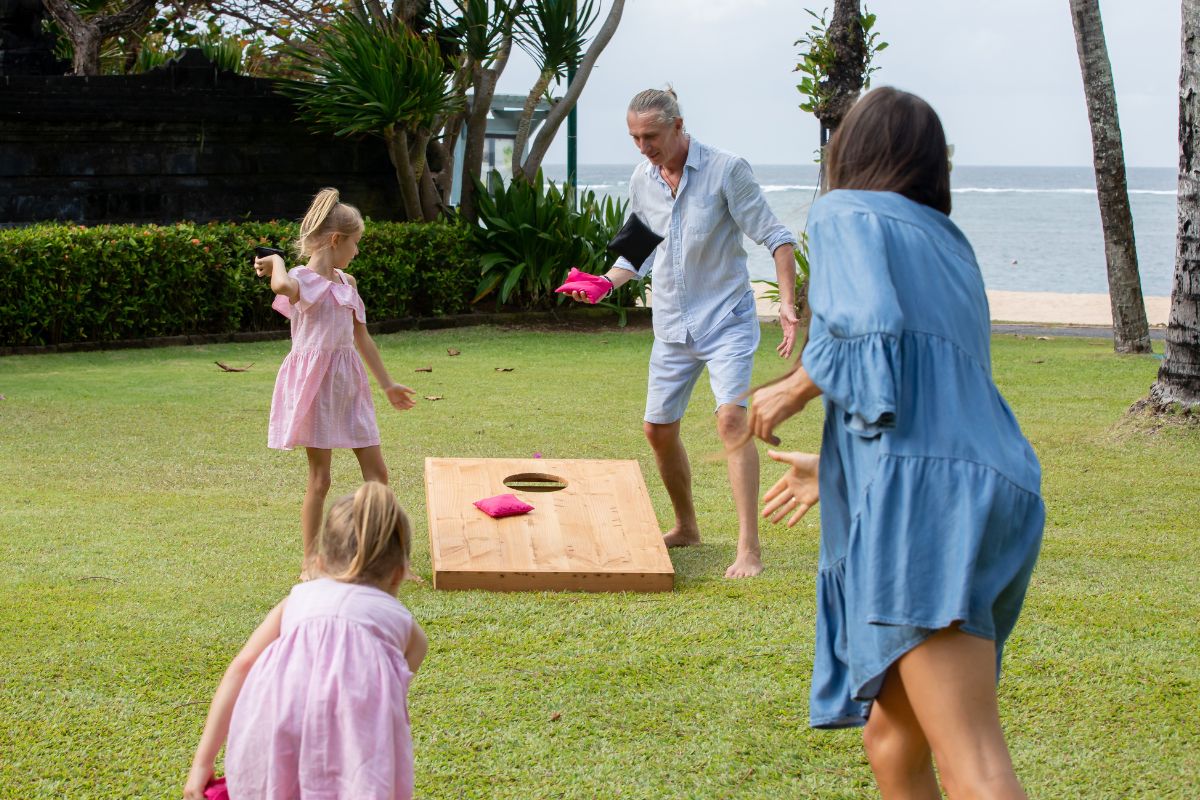Cornhole is a fun game that requires skill and strategy. The boards used in the game can significantly impact how you play. It’s essential for all players, whether new or experienced, to understand these boards.
This guide will teach you about cornhole strategies, including how to grip and throw and how to plan your moves. It will also show you how to adjust to various situations and emphasize the need for ongoing learning. These tips will help you enjoy the game more casually or in tournaments.
Understand the Game Equipment
Cornhole is a game heavily relying on its leading equipment, the cornhole boards. You need to know about these boards to get good at this game. Regular-size boards are 4 feet by 2 feet and are great for serious players or tournaments.
Smaller boards are suitable for casual fun or when you need to move them around. The board’s finish can also affect how you play. Boards with prints have a particular texture that can change how the bag slides, while those with a resin finish provide a smoother surface that affects the bag’s decline differently. Knowing these differences can help you adjust your throws and improve your game.
Know Your Grip
The grip you have on the cornhole bag can significantly influence your throws. A standard grip involves placing your fingers spread out on the flat side of the bag, similar to gripping a frisbee.
This grip technique allows for better control over the direction and speed of the bag as it leaves your hand, leading to more precise throws. By mastering the correct grip, you can ensure the bag lands precisely where you want it to on the cornhole board.
Master Your Throw
Cornhole offers various throwing styles that cater to different players, each with advantages. The flat toss, where the bag flies flat through the air, provides stability, making it ideal for beginners.
Meanwhile, the spin toss, which involves the bag spinning in the air, requires more skill but can result in a more controlled landing on the cornhole boards. Experimenting with both styles will help you discover which suits you best, helping you to develop a reliable and effective throwing technique.
Align Your Body
Proper body alignment is another crucial aspect of successful cornhole throws. Your feet, hips, and shoulders should all be pointed toward the cornhole boards.
This alignment ensures your throw is directed straight at the target, increasing the chances of the bag landing on the board or even going through the hole. By maintaining a correct stance and body alignment, you can improve the accuracy of your throws and score more points in the game.
Aim Consistently
Consistency is crucial when it comes to aiming in cornhole. Whether you aim directly for the hole or try to bounce the bag off the board depends on your preference and skill level.
However, maintaining consistency in your aiming strategy will result in more predictable results. By focusing on a consistent aim, you can develop a reliable throwing pattern that increases your chances of landing the bag on the board or in the hole, enhancing your overall gameplay.
Control Your Throw
In a cornhole, controlling the speed and height of your throw can significantly impact where the bag lands on the cornhole boards. A higher throw might cause the bag to bounce more upon landing, but it could also help avoid bags blocking the way to the hole.
On the other hand, a faster throw might cause the bag to slide further on the board, potentially leading to overshooting the board altogether. Understanding how to control your throw in terms of speed and height is crucial for improving accuracy and consistency in your game.
Develop Offensive and Defensive Tactics
Cornhole isn’t just about scoring points; it’s also about preventing your opponent from scoring. An offensive strategy could involve aiming directly for the hole to maximize your score.
A defensive technique, meanwhile, might include placing your bag to block the cavity, thereby preventing your opponent from scoring. Understanding when to use each tactic based on the state of the game can give you a competitive edge over your opponents and add an extra layer of strategy to your game.
Practice Regularly
Regular practice is critical to improving your cornhole skills like any other sport or game. Create a routine that involves practicing different aspects of the game, such as aiming, controlling your throwing speed, and employing various tactics.
Practicing on other cornhole boards can also help you adapt to multiple game conditions, making you a more versatile player. The more you play, the more comfortable you’ll become with the game’s nuances and the better you’ll perform in actual matches.
Continuous Learning
Finally, always be open to learning and improving. Even the most experienced players can discover new strategies and techniques to enhance their game.
Watch other players pick up new tactics, join local cornhole clubs to learn from a community of enthusiasts, and participate in tournaments to test your skills in competitive settings. And most importantly, remember to enjoy the game. After all, cornhole is about having fun as much as skill and strategy.
Game Changer – How Cornhole Boards Influence Your Winning Strategy
In conclusion, mastering the game of cornhole involves more than just tossing a bag towards a hole. The cornhole boards are pivotal in defining your game strategy, influencing everything from your throw’s speed and height to your offensive and defensive tactics.
Regular practice, adaptation to varying conditions, and continuous learning are critical elements to improving your performance on cornhole boards. Whether you’re aiming for casual fun or competitive play, understanding these aspects will enhance your cornhole experience, making each throw more rewarding and every game more exciting.











